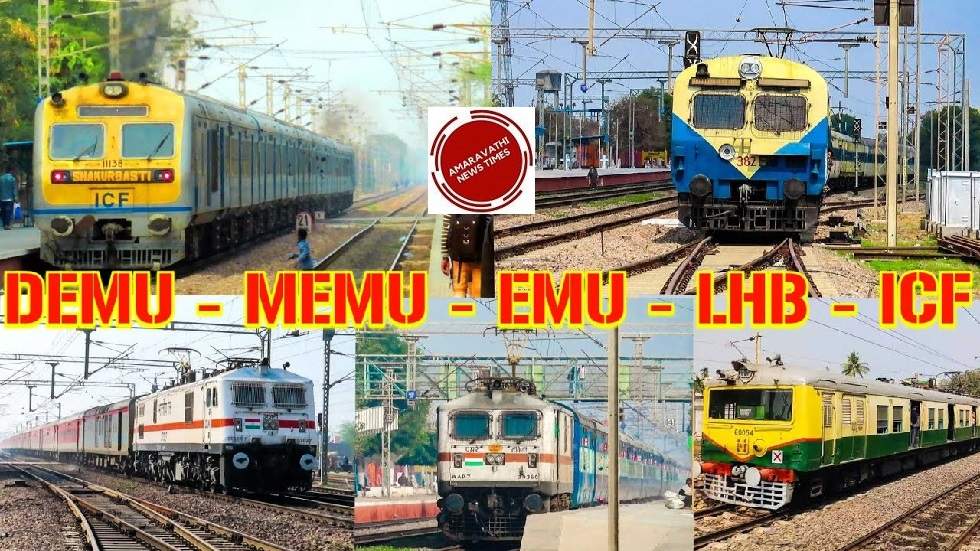
Know About MEMU, EMU, DEMU Trains & LHB Coaches in Detail
Indian Railways:
You have travelled in trains many times. Express, Superfas, Mail Express are associated with the names of long distance trains. When you travel on short-distance trains, the English words DEMU (DEMU), EMU (EMU) or Memu (MEMU) are added to their names.
DEMU Trains:
DEMU stands for “Diesel Electric Multiple Unit,” which refers to a type of train that is powered by a combination of diesel engines and electric motors. DEMU trains are commonly used in many countries around the world, particularly in regions where electrification of railway lines is limited or uneconomical.
Here are some key characteristics and features of DEMU trains:
Power Source:
DEMU trains typically have diesel engines that generate electricity to power electric motors. The diesel engines are usually located in a separate compartment of the train, away from passenger areas, to reduce noise and vibration.
Electric Traction:
The electricity generated by the diesel engines is used to power electric motors, which drive the train’s wheels. This electric traction system offers better acceleration and efficiency compared to traditional diesel-only trains.
Multiple Units:
DEMU trains are composed of multiple units, each with its own diesel engine and electric motor. These units are typically interconnected to form a complete train set. The number of units can vary depending on the train’s design and intended purpose.
Flexibility:
DEMU trains are known for their versatility and flexibility. They can operate on both electrified and non-electrified tracks, allowing them to serve routes with varying infrastructure. This makes DEMU trains suitable for both urban and rural areas.
Reduced Emissions:
While DEMU trains use diesel engines, they generally have lower emissions compared to traditional diesel locomotives. The electric propulsion system helps optimize fuel consumption and reduce greenhouse gas emissions, making DEMU trains a more environmentally friendly option.
Passenger Comfort:
DEMU trains are designed with passenger comfort in mind. They often feature air-conditioned cabins, comfortable seating, and amenities such as onboard toilets and storage space for luggage.
Regional and Suburban Service:
DEMU trains are commonly used for regional and suburban rail services, connecting smaller towns and cities. They are often preferred for their cost-effectiveness and ability to operate on non-electrified lines, providing reliable transportation options to areas with limited rail infrastructure.
It’s worth noting that the specific features and configurations of DEMU trains can vary between different manufacturers and regions.
EMU Trains:
EMU stands for Electric Multiple Unit, which refers to a type of train that is powered by electricity and consists of multiple self-propelled carriages. EMU trains are commonly used for suburban and regional passenger transportation.
Here are some key features of EMU trains:
Electric Power:
EMU trains are powered by electricity, typically supplied through overhead wires or a third rail system. This electrical power is used to operate the train’s motors, which drive the wheels and propel the train forward.
Multiple Units:
EMU trains consist of multiple carriages or units, each equipped with its own traction motors and control systems. This distributed power arrangement allows for better acceleration, braking, and flexibility in train composition.
Self-Propelled:
Unlike traditional locomotive-hauled trains, EMU trains do not require a separate locomotive to pull them. Each carriage of an EMU has its own propulsion system, enabling it to move independently or in coordination with other carriages.
Interconnected Carriages:
The carriages in an EMU train are usually connected by flexible gangways, allowing passengers to move freely between them. This provides convenience and accessibility throughout the train.
Regenerative Braking:
EMU trains often employ regenerative braking, a technology that converts the train’s kinetic energy into electrical energy during braking. This energy is then fed back into the power supply system, reducing overall energy consumption and improving efficiency.
High Frequency:
EMU trains are commonly used in high-demand commuter routes, where they offer frequent and reliable service. Their self-propelled nature and multiple units allow for frequent departures and shorter headways between trains.
Passenger Comfort:
EMU trains are designed to provide a comfortable and smooth ride for passengers. They often feature amenities such as air conditioning, comfortable seating, onboard information systems, and sometimes even Wi-Fi connectivity.
Regional and Suburban Use:
EMU trains are primarily used for regional and suburban passenger transportation, connecting urban centers with surrounding areas. They are particularly well-suited for commuter routes, where frequent stops and short to medium distances are typical.
Overall, EMU trains have proven to be an efficient and effective solution for providing electric-powered transportation on high-demand rail lines. They offer environmental benefits, improved passenger experience, and play a significant role in modern railway systems around the world.
MEMU Trains:
MEMU (Mainline Electric Multiple Unit) trains are a type of electric multiple unit (EMU) train used in India for suburban and short-distance passenger services. MEMU trains are designed to run on broad gauge tracks and are primarily used for commuter transport in densely populated areas. Here are some key features and characteristics of MEMU trains:
Electric Multiple Unit:
MEMU trains are electrically powered and consist of multiple self-propelled coaches. They do not require a locomotive to pull them and can operate independently.
Mainline Operation:
Unlike suburban EMU trains that operate within a city or its outskirts, MEMU trains are designed for mainline operation. They connect cities and towns within a region, typically covering distances of up to 200 kilometers.
Passenger Capacity:
MEMU trains have a high passenger capacity to cater to the commuter demand on mainline routes. The number of coaches in a MEMU train can vary, typically ranging from 8 to 12.
Speed and Performance:
MEMU trains are capable of reaching higher speeds compared to suburban EMU trains. They can attain speeds of up to 100 km/h, allowing for faster transportation between towns and cities.
Electrical Systems:
MEMU trains draw power from the overhead catenary system (OCS) or overhead wires. They are equipped with electric traction motors and use regenerative braking to recover energy during braking, increasing overall energy efficiency.
Seating Arrangement:
The seating arrangement in MEMU trains is generally a mix of both longitudinal and transverse seating. Longitudinal seating refers to seats placed along the length of the coach, while transverse seating involves seats arranged facing each other.
Facilities and Amenities:
MEMU trains are equipped with basic passenger amenities, including comfortable seating, overhead luggage racks, and toilets. However, the amenities provided may vary based on the specific train and its configuration.
MEMU trains have played a crucial role in improving connectivity and easing commuter traffic in various regions of India. They are an important part of the country’s rail transportation infrastructure, especially for short-distance travel between towns and cities.
LHB Coaches
LHB (Linke Hofmann Busch) trains are a type of passenger railway coaches used in various countries, including India. LHB coaches are known for their improved safety features, enhanced passenger comfort, and higher speed capabilities compared to older conventional coaches. Here are some key features and information about LHB trains:
Safety:
LHB coaches are designed with a strong, crashworthy shell that offers better protection to passengers in the event of an accident. These coaches have anti-climbing features, which prevent them from toppling over or climbing on each other during a collision. The design also includes fire-retardant materials and improved evacuation systems.
Passenger Comfort:
LHB coaches provide better comfort to passengers with features like modular interiors, ergonomic seating arrangements, wider windows, improved ventilation, and advanced suspension systems. These coaches offer a smoother and quieter ride, reducing noise and vibrations.
Air Conditioning:
LHB coaches are equipped with efficient air conditioning systems, ensuring a comfortable temperature inside the train regardless of the weather outside.
Higher Speeds:
LHB coaches are designed to handle higher speeds compared to conventional coaches. They have better stability, improved braking systems, and enhanced suspension to support faster train operations.
Flexibility:
LHB coaches are designed to be modular, allowing for easy reconfiguration of seating arrangements and accommodation of different types of passenger classes, such as sleeper, AC, chair car, etc.
Manufacturing:
LHB coaches are manufactured by Linke-Hofmann-Busch, a German company that specializes in railway technology. Many countries have adopted LHB coaches, and they are also produced under license in India by the Indian Railways-owned company, Rail Coach Factory (RCF) Kapurthala.
Implementation:
In India, LHB coaches were first introduced in the late 1990s. They have gradually replaced older ICF (Integral Coach Factory)-designed coaches on various premium and long-distance train services. LHB coaches are now widely used in Indian Railways for Rajdhani Express, Shatabdi Express, Duronto Express, and other important train services.



